Workers Fleeing America’s Dairyland
Hostile rhetoric and immigration arrests pushing dairy workers out.
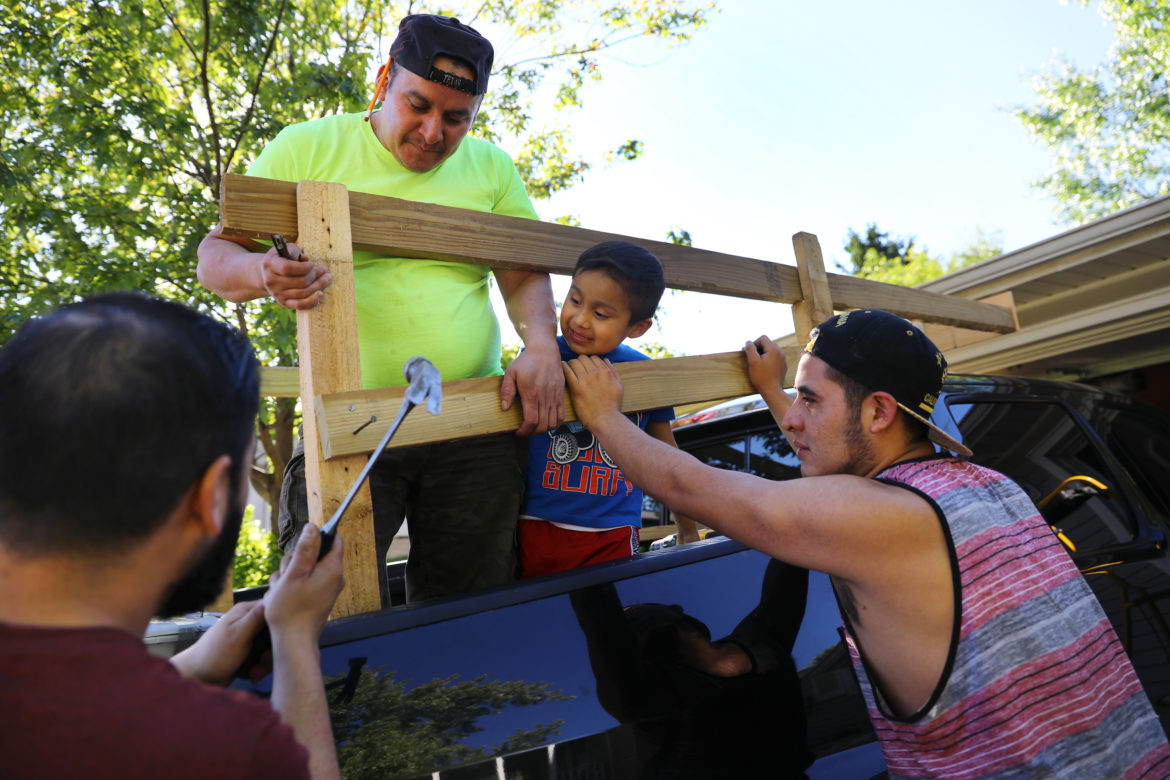
Miguel Hernandez, left, along with co-worker Pedro Tepole, center, and his cousin Eric Hernandez, build a structure on the back of Miguel’s pickup truck on May 31, to help carry their belongings to Mexico. Miguel’s son, Thomas Hernandez, 5, watches the construction project. Hernandez and Tepole, along with three other dairy workers, left for Mexico the following morning. Photo by Coburn Dukehart of the Wisconsin Center for Investigative Journalism.
In the driveway of a two-story house on a dairy farm in western Wisconsin, five men focus on a unique construction project. Using a drill, hammer and nails, plywood and rope, they work together in the afternoon sun to erect a structure that resembles a makeshift corral in the bed of a Honda pickup.
Every so often, Luisa Tepole, 25, carries a suitcase or packaged appliance out of the house, handing it to her husband, Miguel Hernandez, 36. Hernandez makes quick decisions about what can fit in the truck and what his family can live without when they begin their new life in Mexico, placing each item just so for the long trip back across the border.
By the end of the night, the back of the truck is piled high with bags of clothes and shoes, TV sets in boxes and a bucket of children’s toys, ready for the 2,300-mile drive to Veracruz, Mexico.
Farm owners Doug and Toni Knoepke watch Hernandez and the other workers from a few feet away as they load their two-truck caravan. It looks like a scene from “The Grapes of Wrath,” Doug Knoepke remarks, referring to the movie about the mass migration from the Oklahoma Dust Bowl to California in the 1930s.
Only this time, it is in reverse: The migrants are leaving a land abundant with economic opportunity for an uncertain future in their homeland.
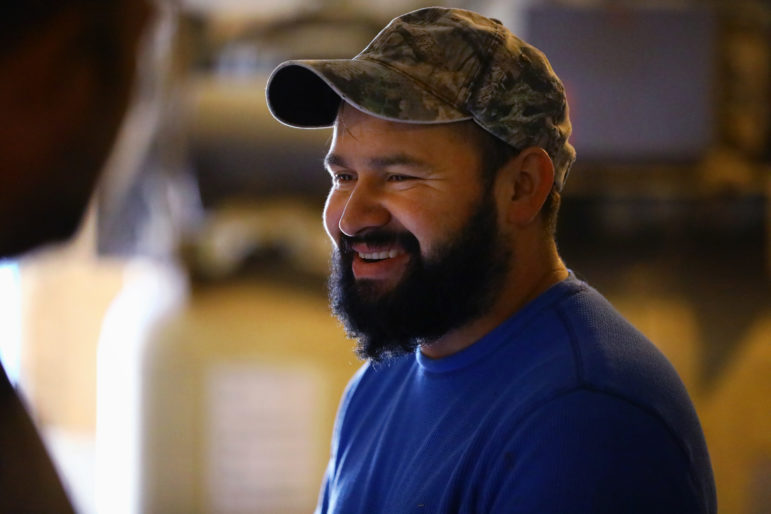
Miguel Hernandez talks with herd manager Henry Yoder during his last shift on a dairy farm in Pepin County. Yoder said Hernandez was one of the only immigrant workers who knew how to fix and manage everything on the farm. Photo by Coburn Dukehart of the Wisconsin Center for Investigative Journalism.
Hernandez has been working on the Knoepkes’ farm in Pepin County for 16 years. He shares this home with his wife and two young sons, Thomas, 5, and Liam, 4.
The house, where they live with several other workers, is so close to the barn that from their back door, the rhythms of Mexican Cumbia music can be heard coming out of a speaker in the milking parlor.
Earlier in the day, at Thomas’ last day at Noah’s Ark Preschool in Durand, he cries as he tells his classmates that he will not be starting kindergarten with them in the fall. He has never been to Mexico, and his teacher pulls out a map to show the students where it is in relation to the United States.
On June 1, Hernandez and four other men, who for years have milked and cared for cows on dairy farms among the hills of western Wisconsin, drive away in the direction of their mountainous hometown of Texhuacan. A few days later, Tepole and the children fly out of Chicago.
The Hernandez family is leaving, in part, because of the threat of deportation — which could ban them from returning to the United States for 10 years — and what they describe as increasingly harsh rhetoric by President Donald Trump and others toward immigrants, especially those here illegally.
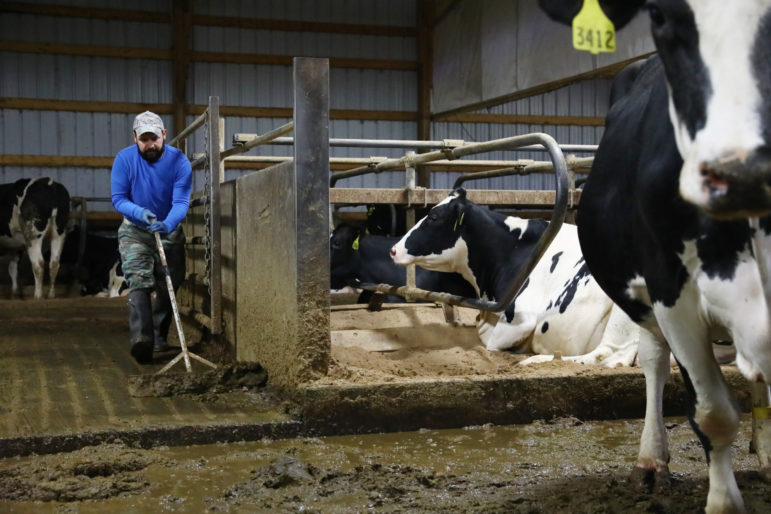
Miguel Hernandez cleans a barn on his last day of work on a Pepin County dairy farm owned by Doug and Toni Knoepke. He said he did not want to work the day before he left, but the farm owners needed the help. At the time, they did not have anyone lined up to replace him as assistant herdsman. Coburn Dukehart of the Wisconsin Center for Investigative Journalism.
Like many immigrant dairy employees in Wisconsin, the workers in the caravan have stories about walking through the desert to cross the border illegally, coming to work for farmers in the United States eager for the help.
They ended up here in America’s Dairyland, the nation’s top cheese state and No. 2 milk producer, attracted by a dairy industry dependent on undocumented immigrant labor to keep cows milked three times a day, year-round. They have raised their children in communities where American workers stopped answering “help wanted” ads for cow milkers long ago.
And now, they are going home.
“Miguel has been our right hand,” Knoepke says. “He treated (the farm) like he owned it. We’re really saddened, scared. I don’t know. It’s sad.”

Miguel Hernandez works his last shift on a Pepin County dairy farm owned by Doug and Toni Knoepke on May 31. Photo by Coburn Dukehart of the Wisconsin Center for Investigative Journalism.
In the first 100 days of the Trump administration, arrests by Immigration and Customs Enforcement (ICE) in the Midwestern region increased over the previous two years.
In Wisconsin, farmers like Knoepke depend heavily on workers like Hernandez. Seeing him and the other workers leave worries this first generation farmer with 650 cows.
“I don’t know where the industry would be without (immigrant labor) right now,” Knoepke says. “We’re relyin’ on it and what it does for Wisconsin and our economy.”
There are temporary visas for seasonal agricultural workers, but year-round workers who make up the vast majority of the labor force on Wisconsin’s large dairies have no special protections, and many are in the country illegally. Unless Congress changes that, Knoepke says, the loss of immigrant farm workers will “bring us to our knees.”
“They better do something … because (workers) are leaving. You see it right here. They’re packin’ up.”
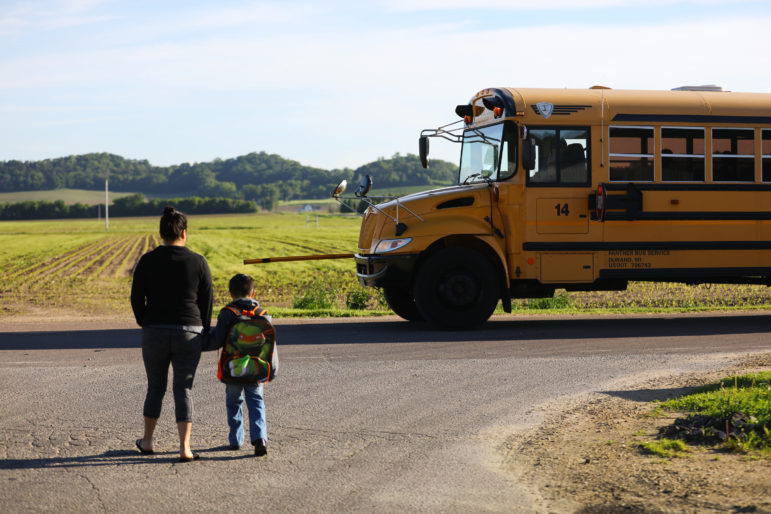
Luisa Tepole walks her son Thomas Hernandez, 5, to the bus on his last day of school in the United States on May 31. Thomas’ preschool class held a graduation ceremony later that day. The rest of his classmates will enter kindergarten next fall. Thomas, who is an American citizen, flew to Mexico with his mother and brother Liam a few days later to start a new life with his family in his parents’ hometown of Texhuacan, Veracruz. Photo by Coburn Dukehart of the Wisconsin Center for Investigative Journalism.
In May, U.S. Sen. Ron Johnson, R-Wis., introduced a bill that would let states create their own visa programs for foreign workers. According to the libertarian Cato Institute, which supports the measure, Canada and Australia have similar programs. Four dairy associations endorsed the proposal, but it has not yet received a hearing.
Tougher U.S. immigration policies are creating concern on the other side of the border as well.
“Our families in Mexico, when they watch TV and the news … they see there are raids in many states so they worry about that,” Hernandez says. “Our bosses always told us don’t worry … but in some states it’s happening.”
Hernandez’s brother, Damaso, who also works at a western Wisconsin dairy farm, says many workers he knows are considering whether to stay or go. As a candidate, Trump declared that the United States was a dumping ground for drugs and criminals from Mexico. He promised sweeping deportations and to build a wall between the two nations.

Thomas Hernandez, 5, participates in his last day at Noah’s Ark Preschool at Assumption Catholic School in Pepin County on May 31. Photo by Coburn Dukehart of the Wisconsin Center for Investigative Journalism.
“Because they’re scared of the government, a lot of families are leaving. Because they can’t get around comfortably anymore because they’re scared of getting taken and deported,” Damaso Hernandez says. “It’s strange, it’s difficult because all the Hispanic people knew the Americans here in Wisconsin were supporting Donald Trump.
“I think they made a mistake,” he adds, “Because a lot of people are fleeing for precisely that reason.”
Trump was the first Republican presidential candidate to carry Wisconsin since 1984.
Arrests up in the Midwest
ICE figures show arrests in the six-state Midwestern region including Wisconsin are rising since Trump took office, Wisconsin Public Radio has learned.
The agency reports that arrests in the Chicago region rose to 2,599 between Inauguration Day, Jan. 20, through April 29, the first 100 days of the Trump administration. That figure exceeds arrest totals from the same period in the previous two years under President Barack Obama. However, it is lower than the same period in 2014, when there were 3,033 arrests.
Nationwide, ICE arrests totaled 41,898, about 35 percent higher than last year but lower than the 2014 figure of 54,584.
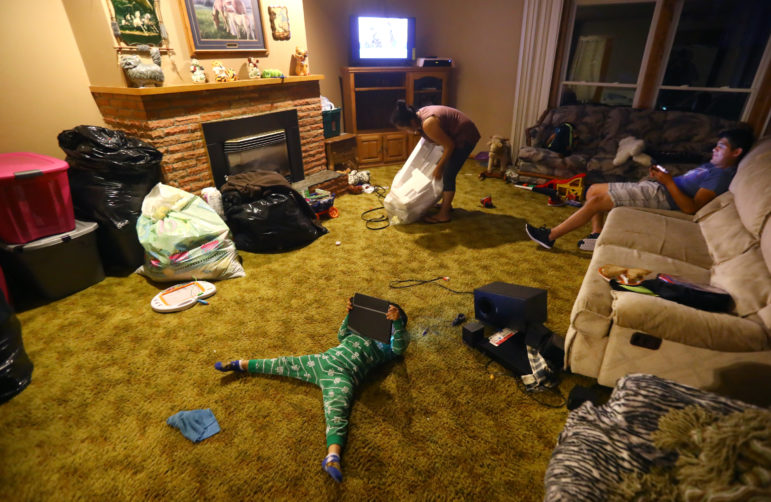
Luisa Tepole packs personal items in preparation for her family’s journey to Mexico while her husband’s nephew, Hernan Hernandez, hangs out on the couch. Miguel Hernandez was leaving two days later for Mexico. In the foreground is their son Liam, 4. The family shared this home on a Pepin County dairy farm with several other workers. Photo by Coburn Dukehart of the Wisconsin Center for Investigative Journalism.
Randy Capps, director of research for U.S. programs at the Migration Policy Institute, a nonpartisan group that analyzes the movement of people worldwide, says there can be a “pretty substantial lag” between arrest and deportation. Factors include whether the person contests the deportation.
“And that lag can be anywhere from a few days — if they have a prior removal order that’s simply reinstated — to several years, if they decide to contest their deportation and they’re let out of detention on bond,” Capps says.
The Trump administration is working to pressure local law enforcement agencies and governments to help federal authorities identify and arrest undocumented residents. The president’s budget proposes withholding funds from so-called “sanctuary cities,” jurisdictions that decline to work hand-in-hand with federal agencies to enforce immigration laws.
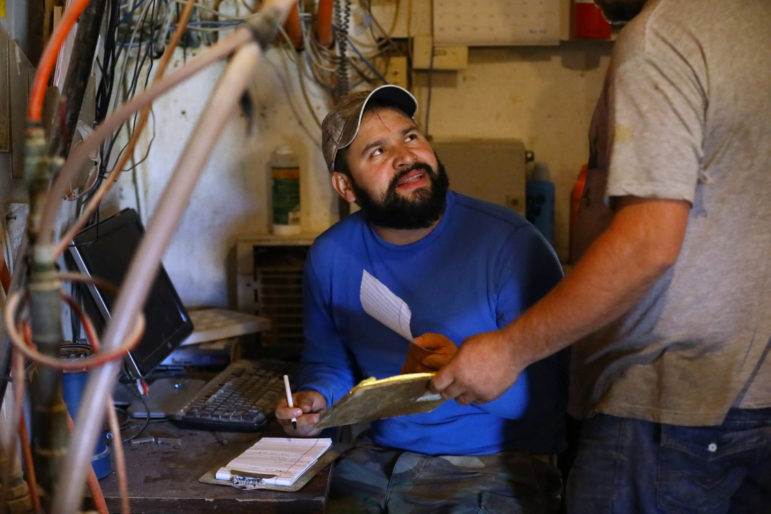
Miguel Hernandez talks with herd manager Henry Yoder during his last shift on a dairy farm in Pepin County. Yoder said Hernandez was one of the only immigrant workers who knew how to fix and manage everything on the farm. Photo by Coburn Dukehart of the Wisconsin Center for Investigative Journalism.
In May, Texas Gov. Greg Abbott signed a bill into law that allows local police officers to question individuals about their immigration status when they are detained or arrested. It also penalizes local officials who do not cooperate with federal immigration agents by handing over people subject to deportation. Republicans in the Wisconsin Legislature have proposed a similar bill.
Implementation memos issued by the U.S. Department of Homeland Security earlier this year expanded ICE’s target from individuals convicted of serious crimes to those charged with even low-level offenses. The memos also direct that no one in the country illegally is exempt from deportation.
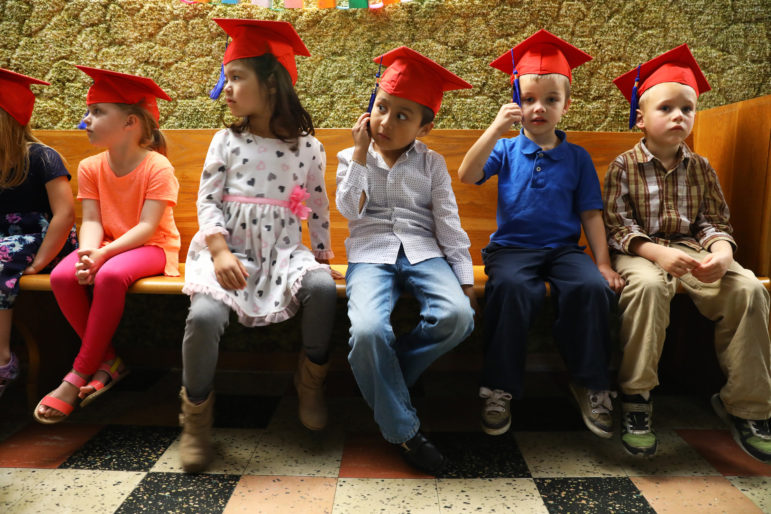
Thomas Hernandez, 5, waits in a church basement with his 4K classmates from Noah’s Ark Preschool at Assumption Catholic School before their graduation ceremony on May 31. Photo by Coburn Dukehart of the Wisconsin Center for Investigative Journalism.
Nationwide, the number of non-criminals arrested by ICE in Trump’s first 100 days more than doubled from the same period last year, to 10,934 from 4,372. In the Chicago region, for example, 778 of the 2,599 people arrested by ICE were not convicted criminals; last year, 500 non-criminals were arrested during the same time frame.
What that means is that people who come into contact with ICE, even if they are not being sought by the agency, could still be arrested.
“That’s what they call collaterals,” says Wendy Feliz, spokeswoman for the pro-immigrant American Immigration Council. “ ‘We’re gonna pick you up because you’re undocumented and we’re here anyway.’”

Luisa Tepole takes a photo of her son Thomas Hernandez with his preschool teacher, Angela Tulip, after the graduation ceremony for Noah’s Ark Preschool at Assumption Catholic School. Miguel Hernandez stands behind her. Photo by Coburn Dukehart of the Wisconsin Center for Investigative Journalism.
A farmer in Wisconsin’s Trempealeau County, who asked not to be named because he fears reprisals from immigration authorities, says ICE agents who visited his farm this spring looking for a particular person warned him they knew the rest of his employees were also undocumented and that they would be back. A worker who spoke to Wisconsin Public Radio at another farm in Pepin County shared a similar report.
Experts like Feliz, however, say there is no evidence of the type of sweeping raids carried out near the end of the George W. Bush administration.
ICE may be under pressure from businesses not to run intensive operations in fields or factories where many undocumented immigrants work, Capps says.
“If they were to take a bunch of agricultural workers, or even if they were to scare a large number of agricultural workers away, that could have a bad impact on the local economy,” he says.

Thomas Hernandez, 5, hugs his friend Brayden Patnode, after the graduation ceremony for Noah’s Ark Preschool at Assumption Catholic School. Brayden’s mom, Jennifer Patnode, left, had just learned the Hernandez family was moving to Mexico, and that Thomas would not be back at school the following year. Photo by Coburn Dukehart of the Wisconsin Center for Investigative Journalism.
University of Wisconsin-Extension agent Jennifer Blazek says immigrant dairy workers across the state remain uneasy.
“I do think that it may not be as openly discussed as it was when we saw more news about immigration in the national media,” Blazek says. “Nothing has really happened to lessen their fears; there’s no new information from the government about the wall and other immigration policies.”
‘They’re coming after us’
As rumors circulated that ICE had visited Durand, four other dairy workers decided to join Hernandez, whose reasons for leaving include returning to see his ailing father.
“I think the family is the most important thing for all of us,” says Hernandez, who always knew he would someday return to Mexico. He and his friends determined it was best to go now — organized, relaxed and with a plan.
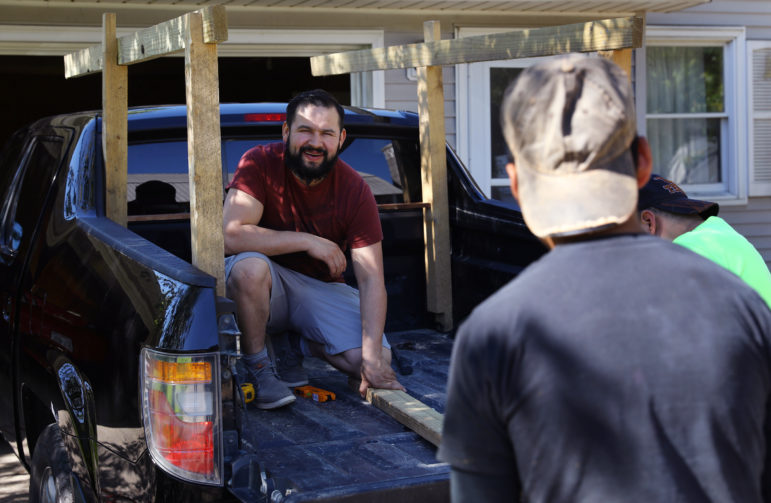
Miguel Hernandez, along with two friends, builds a structure on the back of his pickup truck on May 31, to help carry his belongings to Mexico. Photo by Coburn Dukehart of the Wisconsin Center for Investigative Journalism.
“It’s better to go back home because of the laws — they’re coming after us,” says Luis Mendez, 32, who milks cows and helps out as a mechanic at the Knoepke farm. “It’s better to go willingly and be with the family rather than getting deported or something like that.”
If you are deported, he says, “You take the clothes you’re wearing … and that’s it.” But with a planned departure, Mendez says, immigrants can keep their belongings and money.
“This way I’m going calmly, at ease.”
Still others, like Hernandez’s brother Damaso — who has lived in the United States for 17 years — say the time has not come to leave, but the situation could change at any moment. He thinks about the effect of leaving on his four children, who were raised in Wisconsin.
“My kids are very accustomed to life here. The truth is, I don’t know what type of life they would have over there. Would they adapt quickly or…,” he trails off. “That’s what scares me most is the adjustment … life is different over there.
“Various people have already gone. And others want to leave. Now that (Miguel) is leaving I’m asking myself, ‘And you, when will you leave?’ ”
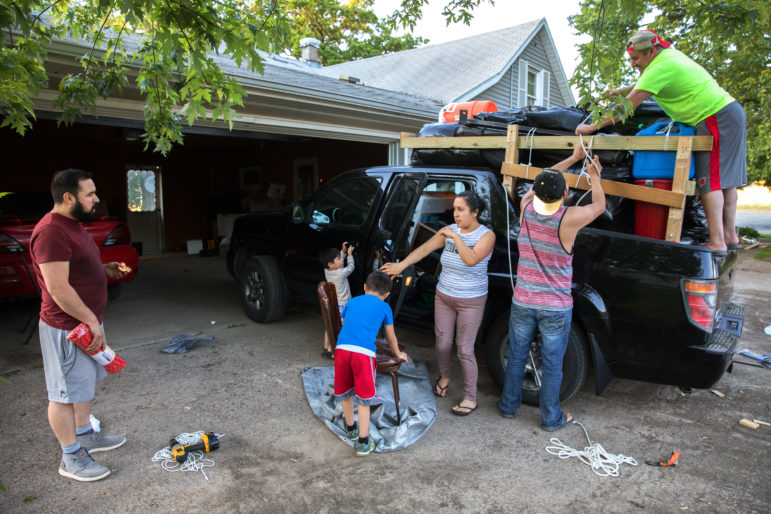
Miguel Hernandez, left, talks with his wife, Luisa Tepole, about what to load into their pickup truck as they prepare to return to their hometown in Mexico. His cousin, Eric Hernandez, and co-worker Pedro Tepole, right, help to load the truck a little after 8 p.m. on May 31. Miguel and Pedro had already worked a full-shift on the Knoepke’s dairy farm in Pepin County, Wis. Photo by Coburn Dukehart of the Wisconsin Center for Investigative Journalism.
Last day for father and son
It is 7:15 in the morning on May 31. As the sun peeks over the hills to the east, workers are up and in action. One drives a tractor through the fields while another steers a feed truck between two rows of cows. All the while, men in the milking parlor never stop moving. Some have been working since 11 p.m. and are just finishing their shifts.
At this hour, everyone on the farm is an immigrant from Mexico.
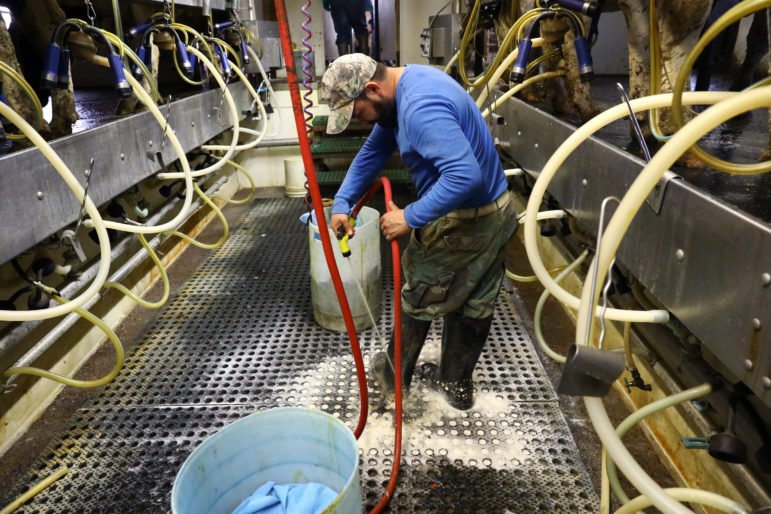
Miguel Hernandez hoses off his boots in the milking parlor at the end of his last shift after 16 years on a Pepin County dairy farm. He punched out at 1 p.m., as his final shift officially ended. Photo by Coburn Dukehart of the Wisconsin Center for Investigative Journalism.
For Hernandez, today is just like any other workday over the past 16 years, except that it is his last. He does not want to work today, but his bosses say they really need the help. He opens and closes metal gates, shoo-ing cows in and out of the milking parlor, and sweeps piles of manure and feed off the floor of the barn.
Tepole is excited. She has not been back home in the 11 years since she first came to the United States. Her parents have never met their grandchildren, and her mother is happy they are coming home.
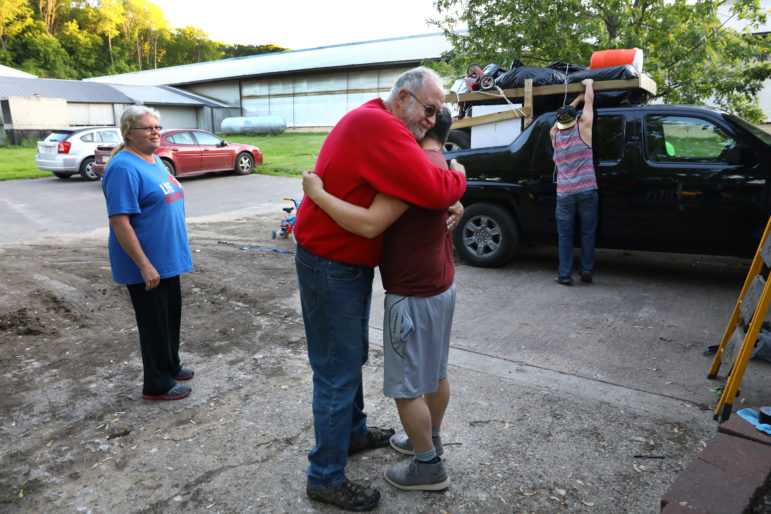
Doug Knoepke, owner of a large dairy farm in Pepin County, Wis., hugs Miguel Hernandez on May 31, as he prepares to leave after 16 years. “I don’t know where the industry would be without (immigrant labor) right now,” says Knoepke. Miguel, his assistant herdsman and “right hand” man has proven difficult to replace. Photo by Coburn Dukehart of the Wisconsin Center for Investigative Journalism.
At school, Thomas’ teacher gives the students certificates to congratulate them on finishing the school year. On Thomas’, she writes her address and encourages him to write from his new home.
Hernandez knows his decision to raise his children in Mexico will affect their future, especially when it comes to education. “It’s a huge difference in school here compared to the school in Mexico. I think we are a lot behind in Mexico, but … it is what it is,” Hernandez says, shrugging his shoulders.
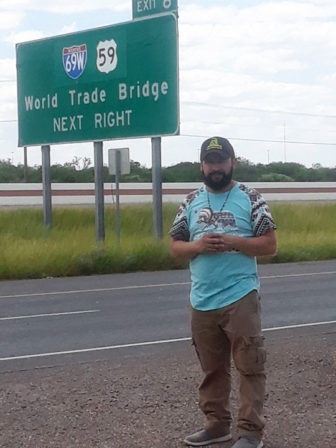
Miguel Hernandez waits in Laredo, Texas after his pickup truck failed an emissions test while attempting to cross the U.S. border with Mexico. The truck was cleared later that afternoon, and Hernandez has since reunited with his wife, children and extended family in the state of Veracuz, Mexico. Photo courtesy of Miguel Hernandez.
“He thinks we are going to come back. I just hope he forgets about that when we get down there and he sees his family down there and his cousins. I have a big family, 10 siblings and many nephews and nieces down there, so I hope that helps a lot.”
When Hernandez told his boss he was leaving, he was offered more money to stay. The farm owners even offered to buy a trailer for the other workers so he and his family could live in the house alone. But Hernandez turned it down.
Four or five people have applied for Hernandez’s job, but none has worked out, according to herd manager Henry Yoder. Knoepke says he probably will need to promote from within.
Hernandez says the farm owners want him to come back legally if that ever becomes possible.
“They are waiting for the government to do something … so they can bring people with papers or with visa, but they are just waiting,” Hernandez says. “You don’t even know if it’s gonna happen.”
An earlier story identified Miguel Hernandez and Luisa Tepole as “Manuel and Rosa Jiménez” to protect their identities. The couple has since chosen to be identified.
The nonprofit Wisconsin Center for Investigative Journalism (www.WisconsinWatch.org) collaborates with Wisconsin Public Radio, Wisconsin Public Television, other news media and the UW-Madison School of Journalism and Mass Communication. All works created, published, posted or disseminated by the Center do not necessarily reflect the views or opinions of UW-Madison or any of its affiliates.



















Can’t feel sorry for any of them if they came here ILLEGALLY. They broke our laws, now they’ll have to pay!!!
The comments about “relying on immigrant labor” from the dairy farm owners struck me. Is it the “immigrant” part or the “low paid” part? Is the latter only an assumption I’m making, seems there was housing (an indirect, non-monetary) benefit involved in this case…
If it were the “low paid” part, where’s the break even point? Can a dairy farm survive on 650 head? If not, how many? (Too much bigger and it becomes a “factory farm” with all the attendant problems there) If it can’t survive, how much more does a gallon of milk or a pound of cheese need to cost to make it work?
Left “cares” about immigrant labor like a GOP corporate pig stereotype “cares” about low wages.
“A national survey in 2014 of dairy farms conducted by Texas A&M University and commissioned by the National Milk Producers Federation predicted severe losses for the industry if the flow of immigrant workers were to completely halt.
According to researchers, eliminating immigrant labor in the dairy industry would reduce production by 23 percent or 48 billion pounds of milk. The number of farms, currently at around 58,000, would decrease by 7,011. Retail milk prices would increase by 90 percent, meaning a $3 gallon of milk would cost consumers nearly $6, according to the study.
Without immigrants, U.S. economic output would also decrease by $32 billion, eliminating 208,208 jobs in the dairy industry and other businesses that rely on it, researchers predicted.”
http://wisconsinwatch.org/2017/03/under-trump-wisconsin-dairies-struggle-to-keep-immigrant-workers/
“Alabama, which hosted the largest rally of Trump’s presidential campaign Friday night, had been a test kitchen for Trump-style crackdowns on undocumented workers — and it had not gone well.”
https://www.washingtonpost.com/politics/alabama-tried-a-donald-trump-style-immigration-law-it-failed-in-a-big-way/2015/08/22/2ae239a6-48f2-11e5-846d-02792f854297_story.html?utm_term=.2db115047201
So… $15/hr living wage only matters when it is a US citizen? The supply of illegal immigrant workers has artificially depressed the cost of the dairy industry (among others) and things are clearly out of whack. If we had successfully enforced immigration laws for the past couple decades then we could have put legislation in place a long time ago to support LEGAL immigrant workers. Instead we’ve seen people working at extremely low wages without benefits or paying their fully share of taxes. It isn’t good for the families and it isn’t good, in the long run, for the country or the industries that rely on these workers.
Don’t worry AG Trump will solve this.
Vincent, I’m so glad you’re here to provide valuable discourse.
I shared an extremely relevant story to the discourse, which is a hell of a lot more than the first and third commentators did. Got a case of the Mondays AG? Things rough at Johnson Controls? Lighten up man.
One thing which keeps coming to mind in regard to some complaints about how much undocumented workers “cost” the county is the whole notion of their not paying taxes. it would be true if they are being paid under the table/cash, this is posible BUT for it means every week or so, owners would need to have on hand several thousand dollars in cash plus time cards or some sort of records and face the real possibility of an audit by the IRS or State, wouldn’t they? Plus the owner would lose any deductions for business expenses and therefore be paying more in income taxes than they should? And if the workers are paid via check the owner and the worker would need to pay payroll taxes at least for someone who will never collect social security or medicare? Perhaps I am naive but the purpose of the “e-verify” system was to assure citizenship through a social security number and if a false one was used then wouldn’t such taxes never be paid to a non-existent recipient?
We find ourselves in a situation in which rhetoric and racism obscure the need for a discussion of how to meet a labor shortage for industries located in very low population areas as well as be fair to people fleeing areas of economic stagnation and/or narco-terrorism and who are willing to re-locate to areas needing workers as well as losing population as young people from those areas move to the cities. The answers are complex and challenging and probably not at all a “one size fits everywhere”. As a society of immigrants, we should remember our history as well as seek to imagine our future,.
tomw (post 10):
The feds only require E-verify for federal contractors/vendors. As far as Washington is concerned, E-verify is voluntary for all other employers. They can use it if they wish. (If they don’t, they take the risk of losing employees to future ICE raids.)
Some states require e-Verify, but I don’t know if Wisconsin is one of those. And even if Wisconsin started requiring e-Verify today, it wouldn’t apply to EXISTING employees—only to new hires.
Each year about 1.4% to 1.8% of all wages are reported on W-2s with incorrect Social Security numbers (the name on the W-2 doesn’t match the name on the SS account). Some of these W-2s are simply mistakes and are eventually corrected (like somebody changing their name but failing to notify both their employer and SSA), but others (presumably for undocumented workers) never get corrected and just sit there uncredited to any SS account (SSA calls these earnings “in suspense”).
As of the end of 2012, total “suspense” earnings totaled $1.2 trillion dating back to 1937—the dawn of Social Security. Taxes on these earnings have been paid through normal withholding, so it’s not like these undocumented workers don’t pay taxes.
Some taxes are paid, others not. Some illegal immigrants pay taxes, others do not. Over 90% of the taxes paid by illegal immigrants are for sales tax and property tax, not income tax.
This is a small issue compared to what the illegal worker pool does to suppress wages. We have many people in our state that need work, but does it make sense for someone in Milwaukee to uproot themselves or their family in Milwaukee to move to the middle of the state to make an often illegally low wage and work illegally long hours?
tomw, racism…? Really?
AG and TomD thanks for your thoughts and could you offer documentation for your statistics? And yes, AG, I know I’m an old white guy but I do believe that part of our, this society’s problem with undocumented folks is that they are not northern Europeans!
Revtlee (post 14), in 2010, SSA (Social Security Administration) collected about $13 billion in incorrectly attributed payroll taxes (where the W-2’s name differed from that on file for that SS number). Most of this $13 billion is from undocumented workers using phony SS cards. (This $13 billion is IN ADDITION to regular federal—and state—income tax withholding on those earnings; as long as they are paid as employees, they pay the same withholding taxes as everybody else, but, unlike citizens, they cannot file for a refund if they are overwithheld.)
Since the payroll tax rate is 15.3% (6.65% from both employer and employee), these undocumented workers earned AND PAID TAXES ON about $85 billion that year alone.
You can read more here:
https://www.theatlantic.com/business/archive/2016/09/undocumented-immigrants-and-taxes/499604/
Tom D thank you! I thought this was true and one of the “hidden” ways undocumented folks pay taxes for something they will never use or collect.
Almost all of us had ancestors arrive in the USA as undocumented before registration started in about 1897. They showed up on the shores, and were the cheap source of labor of the industrial age. Just as many immigrants are today. Almost all food consumed by Americans passes through the hands of an immigrant working on a farm or processing plant without protection of any laws. It is the 21st Century version of slavery – pure and simple. And Americans are addicted to cheaper food saving billions annually for this cheap source of labor. And yes immigrant labor do pay taxes, but it is this huge savings provided to Americans that most are unaware and unappreciated for the benefits of their back breaking labor.
And our Polish, Irish, Italian, Eastern European, Chinese, Cubans, Hmong, Vietnamese were often treated poorly by the established citizens. Succeeding generations forget or refuse to acknowledge the abuse that was heaped upon their ancestors and repeat the patterns of racism and hate.
In regards to Hispanic immigrants, this is a real misnomer. Hispanic People are the real Americans with DNA connections to First Nation People, with DNA that is unique to the Americas that have had a presence on the continents for over 15,000 years. Hispanic or Latino people belong here, and no paperwork is needed, proof is in their DNA bloodline. If you are of European stock, your ancestry goes by maybe 120 years and at most 417 years as the newcomers and invaders of the Americas. If you are of European stock, maybe we should all go back where we came from.